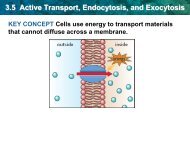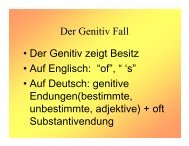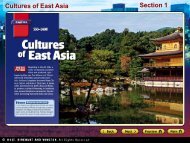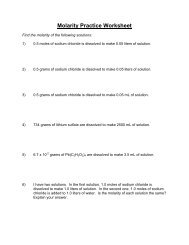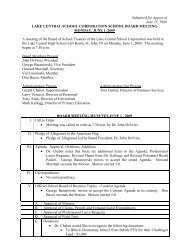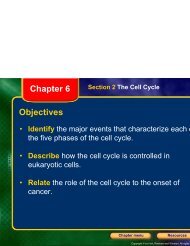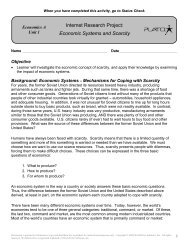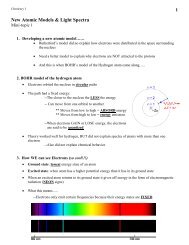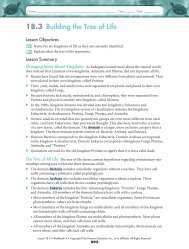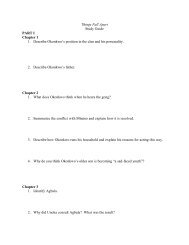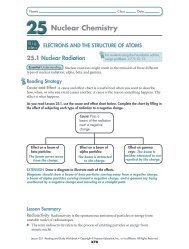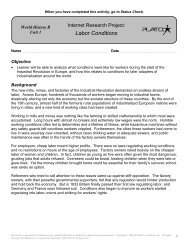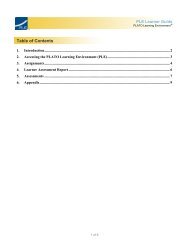An Overview of Animal Diversity - Lake Central High School
An Overview of Animal Diversity - Lake Central High School
An Overview of Animal Diversity - Lake Central High School
Create successful ePaper yourself
Turn your PDF publications into a flip-book with our unique Google optimized e-Paper software.
LECTURE PRESENTATIONS<br />
For CAMPBELL BIOLOGY, NINTH EDITION<br />
Jane B. Reece, Lisa A. Urry, Michael L. Cain, Steven A. Wasserman, Peter V. Minorsky, Robert B. Jackson<br />
Chapter 32<br />
<strong>An</strong> <strong>Overview</strong> <strong>of</strong> <strong>An</strong>imal <strong>Diversity</strong><br />
Lectures by<br />
Erin Barley<br />
Kathleen Fitzpatrick<br />
© 2011 Pearson Education, Inc.
Figure 32.1<br />
<strong>Overview</strong>: Welcome to Your Kingdom
Cell Structure and Specialization<br />
• <strong>An</strong>imals are multicellular eukaryotes<br />
• Their cells lack cell walls<br />
• First <strong>of</strong>f, animals are heterotrophs that ingest their<br />
food (1)<br />
• Their bodies are held together by structural<br />
proteins such as collagen<br />
• Nervous tissue and muscle tissue are unique,<br />
defining characteristics <strong>of</strong> animals (2)<br />
• Tissues are groups <strong>of</strong> cells that have a common<br />
structure, function, or both<br />
© 2011 Pearson Education, Inc.
Reproduction and Development<br />
• Most animals reproduce sexually, with the diploid<br />
stage usually dominating the life cycle (3)<br />
• After a sperm fertilizes an egg, the zygote<br />
undergoes rapid cell division called cleavage<br />
• Cleavage leads to formation <strong>of</strong> a multicellular,<br />
blastula- spherical layer <strong>of</strong> cells enclosing a<br />
hollow, central cavity.<br />
• The blastula undergoes gastrulation, forming a<br />
gastrula.<br />
Video: Sea Urchin Embryonic Development<br />
© 2011 Pearson Education, Inc.
Figure 32.2-3<br />
(4 &15)<br />
Zygote<br />
Cleavage<br />
Blastocoel<br />
Cleavage<br />
Eight-cell<br />
stage<br />
Blastula<br />
Cross section<br />
<strong>of</strong> blastula<br />
Gastrulation<br />
Blastocoel<br />
Endoderm<br />
Ectoderm<br />
Cross section<br />
<strong>of</strong> gastrula<br />
Archenteron<br />
Blastopore
Zygote-The resulting single celled organism that follows the joining <strong>of</strong> sperm<br />
and egg (fertilization)<br />
Blastula- spherical layer <strong>of</strong> cells enclosing a hollow, central cavity.<br />
Gastrula- early state <strong>of</strong> germ layer formation following the blastula stage,<br />
consisting <strong>of</strong> the ectoderm and endoderm, enclosing a central cavity<br />
Blastopore-The opening formed from the invagination <strong>of</strong> the blastula to form<br />
a gastrula<br />
Cleavage-Invagination formed from separated layers or tissue<br />
Gastrulation-Process that converts a blastula to a gastrula.<br />
Metamorphosis- a complete change <strong>of</strong> form, structure, or substance, as<br />
transformation by magic or witchcraft. (5-6)
• Most animals, and only animals, have Hox genes<br />
that regulate the development <strong>of</strong> body form<br />
• Although the Hox family <strong>of</strong> genes has been highly<br />
conserved, it can produce a wide diversity <strong>of</strong><br />
animal morphology (7)<br />
© 2011 Pearson Education, Inc.
Concept 32.3: <strong>An</strong>imals can be characterized<br />
by “body plans”<br />
• Zoologists sometimes categorize animals<br />
according to a body plan, a set <strong>of</strong> morphological<br />
and developmental traits<br />
• Some developmental characteristics are<br />
conservative<br />
For example, the molecular control <strong>of</strong> gastrulation<br />
is conserved among diverse animal groups<br />
© 2011 Pearson Education, Inc.
Body Plan<br />
• <strong>An</strong>imals can be categorized according to the<br />
symmetry <strong>of</strong> their bodies, or lack <strong>of</strong> it<br />
• Asymmetry are organisms that lack a central body<br />
plan (Sponges). (11-12)<br />
• Some animals have radial symmetry, with no<br />
front and back, or left and right<br />
• Two-sided symmetry is called bilateral symmetry<br />
• Bilaterally symmetrical animals have<br />
© 2011 Pearson Education, Inc.<br />
– A dorsal (top) side and a ventral (bottom) side<br />
– A right and left side<br />
– <strong>An</strong>terior (head) and posterior (tail) ends<br />
– Cephalization, the development <strong>of</strong> a head
Body Plan Examples<br />
Asymetrical Radial Bilateral
Figure 32.7<br />
(10 From<br />
Knowledge)<br />
(a) Radial symmetry<br />
(b) Bilateral symmetry
• Radial animals are <strong>of</strong>ten sessile or planktonic<br />
(drifting or weakly swimming)<br />
• Sessile basically equals not moving<br />
• Bilateral animals <strong>of</strong>ten move actively and have a<br />
central nervous system (13-14 From thinking)<br />
© 2011 Pearson Education, Inc.
Tissues<br />
• <strong>An</strong>imal body plans also vary according to the<br />
organization <strong>of</strong> the animal’s tissues<br />
• Tissues are collections <strong>of</strong> specialized cells isolated<br />
from other tissues by membranous layers<br />
• During development, three germ layers give rise to<br />
the tissues and organs <strong>of</strong> the animal embryo<br />
© 2011 Pearson Education, Inc.
• Sponges and a few other groups lack true tissues<br />
• Diploblastic animals have ectoderm and<br />
endoderm<br />
– These include cnidarians and comb jellies<br />
• Triploblastic animals also have an intervening<br />
mesoderm layer; these include all bilaterians<br />
– These include flatworms, arthropods, vertebrates,<br />
and others (16)<br />
© 2011 Pearson Education, Inc.
• Ectoderm is the germ layer covering the embryo’s<br />
surface<br />
• Endoderm is the innermost germ layer and lines<br />
the developing digestive tube, called the<br />
archenteron<br />
• Mesoderm is the middle germ layer and lines<br />
• The ectoderm forms: the central nervous system, the lens <strong>of</strong> the eye, cranial<br />
and sensory, the ganglia and nerves, pigment cells, head connective tissues,<br />
the epidermis, hair, and mammary glands.<br />
• The mesoderm forms: skeletal muscle, the skeleton, the dermis <strong>of</strong> skin,<br />
connective tissue, the urogenital system, the heart, blood (lymph cells), the<br />
kidney, and the spleen.<br />
• The endoderm forms: the stomach, the colon, the liver, the pancreas, the<br />
urinary bladder, the lining <strong>of</strong> the urethra, the epithelial parts <strong>of</strong> trachea, the<br />
lungs, the pharynx, the thyroid, the parathyroid, and the intestines. (17)<br />
© 2011 Pearson Education, Inc.
Body Cavities<br />
• Most triploblastic animals possess a body cavity<br />
• A true body cavity is called a coelom and is<br />
derived from mesoderm<br />
• Coelomates are animals that possess a true<br />
coelom<br />
• A pseudocoelom is a body cavity derived from the<br />
mesoderm and endoderm<br />
• Triploblastic animals that possess a<br />
pseudocoelom are called pseudocoelomates<br />
• Triploblastic animals that lack a body cavity are<br />
called acoelomates (18-20)<br />
© 2011 Pearson Education, Inc.
Figure 32.8<br />
(21)<br />
(a) Coelomate<br />
(b) Pseudocoelomate<br />
Coelom<br />
Digestive tract<br />
(from endoderm)<br />
Pseudocoelom<br />
Digestive tract<br />
(from endoderm)<br />
Body covering<br />
(from ectoderm)<br />
Tissue layer<br />
lining coelom<br />
and suspending<br />
internal organs<br />
(from mesoderm)<br />
Body covering<br />
(from ectoderm)<br />
Muscle layer<br />
(from<br />
mesoderm)<br />
(c) Acoelomate<br />
Body covering<br />
(from ectoderm)<br />
Tissuefilled<br />
region<br />
(from<br />
mesoderm)<br />
Wall <strong>of</strong> digestive cavity<br />
(from endoderm)
• Coelom………What does it do for us?<br />
– Its fluid cushions suspended organs preventing injury<br />
– Cavity enables internal organs to grow and move<br />
independently <strong>of</strong> the outer body wall<br />
– In s<strong>of</strong>t body coelomates the coelom contains non<br />
compressible fluid that acts like a skeleton muscle can<br />
pull from<br />
– (22)<br />
© 2011 Pearson Education, Inc.
Protostome and Deuterostome Development<br />
• Based on early development, many animals can<br />
be categorized as having protostome<br />
development or deuterostome development<br />
• In protostome development, cleavage is spiral<br />
and determinate<br />
• In deuterostome development, cleavage is radial<br />
and indeterminate<br />
• With indeterminate cleavage, each cell in the early<br />
stages <strong>of</strong> cleavage retains the capacity to develop<br />
into a complete embryo<br />
• Indeterminate cleavage makes possible identical<br />
twins, and embryonic stem cells (24-27)<br />
© 2011 Pearson Education, Inc.
Fate <strong>of</strong> the Blastopore<br />
• The blastopore forms during gastrulation and<br />
connects the archenteron to the exterior <strong>of</strong> the<br />
gastrula<br />
• In protostome development, the blastopore<br />
becomes the mouth<br />
• In deuterostome development, the blastopore<br />
becomes the anus<br />
© 2011 Pearson Education, Inc.
Figure 32.9c<br />
(23)<br />
(c) Fate <strong>of</strong> the<br />
blastopore<br />
Protostome development<br />
(examples: molluscs,<br />
annelids)<br />
<strong>An</strong>us<br />
Deuterostome development<br />
(examples: echinoderms,<br />
chordates)<br />
Mouth<br />
Key<br />
Ectoderm<br />
Mesoderm<br />
Endoderm<br />
Digestive tube<br />
Mouth<br />
<strong>An</strong>us<br />
Mouth develops from blastopore. <strong>An</strong>us develops from blastopore.
Figure 32.9a<br />
(28)<br />
(a) Cleavage<br />
Protostome development<br />
(examples: molluscs,<br />
annelids)<br />
Deuterostome development<br />
(examples: echinoderms,<br />
chordates)<br />
Eight-cell stage<br />
Eight-cell stage<br />
Key<br />
Ectoderm<br />
Mesoderm<br />
Endoderm<br />
Spiral and determinate<br />
Radial and indeterminate
Concept 32.4: New views <strong>of</strong> animal<br />
phylogeny are emerging from molecular<br />
data<br />
• Zoologists recognize about three dozen animal<br />
phyla<br />
• Phylogenies now combine morphological,<br />
molecular, and fossil data<br />
• Current debate in animal systematics has led to<br />
the development <strong>of</strong> multiple hypotheses about the<br />
relationships among animal groups<br />
© 2011 Pearson Education, Inc.
Figure 32.11<br />
Porifera<br />
ANCESTRAL<br />
COLONIAL<br />
FLAGELLATE<br />
(29)<br />
True tissues<br />
Metazoa<br />
Eumetazoa<br />
Radial and<br />
diploblastic<br />
Triploblastic<br />
Bilateria<br />
Deuterostomia<br />
Lophotrochozoa<br />
Ecdysozoa<br />
Ctenophora<br />
Cnidaria<br />
Acoela<br />
Echinodermata<br />
Chordata<br />
Platyhelminthes<br />
Rotifera<br />
Ectoprocta<br />
Brachiopoda<br />
Mollusca<br />
<strong>An</strong>nelida<br />
Nematoda<br />
Arthropoda<br />
coelom<br />
Acoelomate<br />
coelom<br />
Pseudocoelomate



